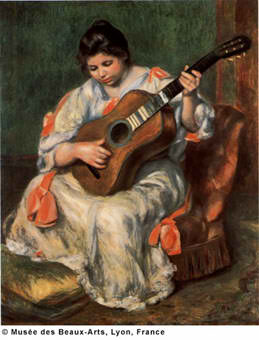
Lesson #8
Pierre-Auguste Renoir (ren-WHAR)
French, 1841-1919
Woman Playing a Guitar, 1896-97
Oil on canvas
31 7/8 x 25 5/8 in.
Musée des Beaux-Arts de Lyon, Lyon, France
Subject
Julie Manet, daughter of Impressionist Berthe Morisot and ƒdouard Manet's brother, Eugène, was charmed to discover this painting in progress in Renoir's studio. "He's doing some ravishing things with a guitar;" she wrote, "a woman with a white muslin dress, held by pink bows, leans gracefully over a large brown guitar, with her feet on a yellow cushion... It's all colored, soft, delicious. "Julie provides a perfect description of this work, which captures a contemplative moment. Julie no doubt saw other paintings from this series of men and women playing the guitar, done late in Renoir's career. The subject may have appealed to the artist for several reasons. Maybe the guitarists were successors to Renoir's earlier paintings of young women playing the piano. Or perhaps he was inspired by the seductive Spanish dancer "la Belle Otero," who performed with Paris's famous entertainment review, the Folies-Bergères.
The artist also loved the enchanting lute players of 18th-century French painting and, especially, the women playing musical instruments by 19th-century painter Jean-Baptiste-Camille Corot. Renoir's career veered from the Impressionist's contemporary Paris life, and the modern dress worn by his earlier models.
This guitar-player wears a simple, white costume. The solid, triangular composition recalls the monumental figures of classical painters Titian and Rubens centuries earlier.
Style
Color and composition make a dramatic impact in this painting. Notice the variety of colors in the skin and dress: warm yellow-gray and pink tones where the figure catches the light, and cool blue-gray and green shades in the shadows. Rich and glowing, the color harmonies capture the play of light and shadow that so interested the Impressionists. In terms of composition, the woman, chair, and guitar are painted to emphasize and repeat voluptuous curves. The curves in the foreground are anchored in space by the crisp verticals and horizontals of the background.
Artist
The son of a tailor, Pierre-Auguste Renoir studied with Monet at the classical Ècole des Beaux-Arts. As an Impressionist, he painted human figures enjoying modern pastimes in light-filled gardens, outdoor restaurants, and cafes. Soft brushstrokes and luminous color characterize his work. "For me a picture should be a pleasant thing, joyful and pretty - yes pretty!" he said. Later in life, he favored the more conservative subjects, solid figures, and centered compositions of earlier, academic art. Like fellow artists Monet and Cassatt, he wondered if the Impressionists' views of a fleeting moment in modern life would interest future generations.
Looking Questions
- This painting shows us a woman playing a guitar as she sits on a cushioned chair. Describe the furnishings that you see.
- What shapes and colors are repeated in this image?
- Where do you see curving lines?
- What color are the shadows?
- What is the focal point of this
- painting?
- How did the artist indicate the focal point?
Activities
The Arts
Ask the students to draw one of their hands. Try drawing the hand alone, and then depict it holding a pencil or paint brush. Have them use chalks or pastels and include all of the colors that are in their skin. Consider the pose or position. Does it look forceful or gentle? What colors did they use?
Math or Science
Many things are repeated in this painting. Play a counting game with your students to see how many things are repeated. Ask how many bows they see. The first student that says the number must point out where the bows are.
If they can identify that number of bows, they win that question. Repeat this process with the following things: circles, rectangles, straight lines, and curvy lines. The right answer is not the main goal of the game. The goal is to get the students to observe the painting closely.
Language Arts
Have the students pretend they are either the musician in this painting or the artist who is creating the painting. Then, have them create a diary as if they were one of these people. Have them describe the moments surrounding the creation of this painting.
Social Studies
The woman in this painting is playing a guitar, which is a hobby or leisure-time activity. List other late 19th-century, leisure-time activities by looking at the other transparencies. Compare and contrast them to the leisure-time activities of present day. List the similarities and differences. How accurately did the artist depict the guitar and its playing? Check with the guitarists in the class.
Continue reading on to the next page, #9: Degas, Before the Performance.
